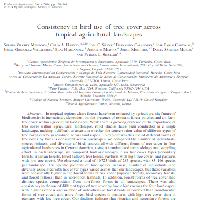Resumen
- In tropical regions where forests have been replaced by agriculture, the future of biodiversity is increasingly dependent on the presence of remnant forest patches and on-farm tree cover within agricultural landscapes. While there is growing evidence of the importance of tree cover within agricultural landscapes, most studies have been conducted in a single landscape, making it difficult to ascertain whether the conservation value of different types of tree cover can be generalized across landscapes. To explore whether use of different forms of tree cover by birds is consistent across landscapes, we compared the number of individuals, species richness, and diversity of birds associated with different forms of tree cover in four agricultural landscapes in Central America, using a standardized methodology and sampling effort. In each landscape, we compared bird assemblages in six tree cover types (secondary forests, riparian forests, forest fallows, live fences, pastures with high tree cover, and pastures with low tree cover). We observed a total of 10 723 birds of 283 species, with 83-196 species per landscape. The specific patterns of bird species richness, number of individuals, and diversity associated with tree cover types varied across the four landscapes, but these variables were consistently higher in the forest forms of tree cover (riparian forests, secondary forests, and forest fallows) than in non-forest habitats. In addition, forest forms of tree cover had distinct species composition from non-forest forms in all landscapes. There was also consistency in the use of different types of tree cover by forest birds across the four landscapes, with higher richness and number of individuals of forest birds in forested than non-forested forms of tree cover, and more forest bird species in pastures with high tree cover than in pastures with low tree cover. Our findings indicate that riparian and secondary forests are consistently of higher value for bird conservation (particularly for forest species) than live fences and pastures with tree cover. Consequently, agricultural and land use policies that promote the retention of secondary and riparian forests and increase tree cover within pastures would greatly benefit bird conservation, regardless of the landscape in which they are applied.
